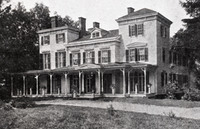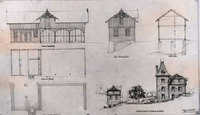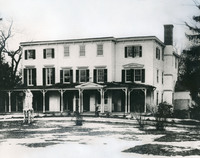Bech Homestead & Family History by Dr. Brian Henry Desilets
The Bech Property
In the mid-1800s Edward Bech, a Danish immigrant, purchased 65 acres of land along the Hudson River which he named the Rosenlund Estate. The grounds were developed circa 1865, during a period when major tracts of Hudson River land were being purchased by wealthy businessmen for country estates. Bech was a partner in the Poughkeepsie Iron Works Company, a thriving riverfront industry that prospered with the advent of the Delaware and Hudson Canal and Railroad. He was also a partner in the Cunard Steamship Company and from 1842 to 1858 was the first Danish Consul in New York.
A friend and fellow countryman of Bech's, Detlef Lienau, was a prominent architect. Bech commissioned Lienau to design a main house of stone as well as several out buildings for his estate. The European-educated Lienau had come to New York in 1848 and established himself as one of America's leading architects. His design of the first example of the French Second Empire style in New York and the introduction to America of the mansard roof typified by the French chateau were among his many achievements. He also was a co-founder of the American Institute of Architects and actively participated in its formative years.
Due to Bech's death in 1873, Lienau's design for the main house was never executed; however, Greystone, St. Peter's, and the Gate House survive as the few remaining examples of Gothic Revival Estate architecture along the Hudson River. All three buildings have been listed on the National Historic Register.
In 1905 the Marist Brothers purchased the McPherson Estate just north of the Bech property and established St. Ann's Hermitage. In 1908 the Marist Brothers acquired the Rosenlund Estate, joining the two properties to form the core of the present Marist College campus.
Gothic Revival Architecture
Gothic Revival Architecture was an architectural movement, or style, in which forms and details of buildings were derived from the Gothic style of the Middle Ages. Beginning in Europe in the early 18th century the movement spread to America where it strongly influenced many architects and their buildings into the 20th century.
In the last 60 years of the 19th century this architectural style was often called Victorian, after Queen Victoria (1819-1901), during whose reign (1837-1901) it was built. The movement was given great impetus when the Queen insisted that architects Sir Charles Barry (1795-1860) and Augustus Welby Northmore Pugin (1812-1852) use the Gothic Revival style for English Houses of Parliament, which were designed in 1836 and completed in 1860.
From about the beginning of the 18th century Gothic Revival has been based on imagination, emotions, the unconventional, mysticism and the implied true Christianity of medieval forms and ornament. Gothic Revival architecture got off to a slow start in the United States. The first building of national importance was Trinity Church (1846), built in New York City, and designed by Richard Upjohn (1802-1878). This church received widespread recognition and helped greatly in the establishment of Upjohn as the dominant church architect and Gothicist of his time and as one of the most successful architects of all time. It also helped greatly in establishing a tradition of Gothic Revival as the predominant style for churches, a tradition that has lasted in some degree to the present time.
The Architect
Detlef Lienau was born in Utersen, Denmark, and had early visions of becoming an architect. At the age of 19 he began a three year apprenticeship with master carpenters in Berlin. He headed for Paris in 1842 where he studied under Henri Labrouste. Lienau made his way to America in the fall of 1848 on a boat chartered by his brother Micheal, who had already established a New York firm called Lienau & Co.
In 1849 Lienau designed his first building in America, a house for his brother in Jersey City, NJ. The following year he designed a New York City townhouse which would change the skyline of the city.
He went on to build many more homes throughout his years in America and the most distinctive feature of all his homes was the "mansard roof" which had first been used in 17th-century France. Lienau had become familiar with it while he was a student in Paris. This new style of a roof caught on immediately in a city that was looking to France for its food, dress and taste.
Lienau was a friend and fellow countryman to the Poughkeepsie industrialist, Edward Bech. Bech hired Lienau to design a main house of stone as well as several dependencies or out buildings for the Rosenlund estate. The Greystone building, St. Peter's and the Gatehouse all survive today as the few remaining examples of Gothic Revival estate architecture.
Sadly, Lienau passed away in New York City in 1887. His contributions to the architectural profession were later recognized in a tribute written by the American Institute of Architect's board of trustees.
The architectural sketch below shows on the left the stables and on the right the carriage house that Detlef Lienau designed for the Bech family. The carriage house is known today as Greystone and houses the college president's office, the admissions office and the Ecommerce lab. This architectural image was featured in the 1992 issue of Marist Magazine.
The Novitiate
In 1906 the first Marist Brothers postulant (an applicant to the Marist Order) was sent from Poughkeepsie to Canada for his training. He could not speak French and soon left as he found it impossible to adjust. It was obvious that an English-speaking American Novitiate would be needed. Thanks to a $28,000 interest-free loan, the Bech estate, which was on 75 acres south of the Waterworks Road, was purchased.
Edward Bech had contracted with Detlef Lienau, a prominent architect, to construct, in stone, a series of buildings which would serve as a homestead, a stable, a gardener's house and gate house. The homestead, the main building on the Bech estate, was used as a Novitiate by the Marist Brothers. It housed the postulants and the novices. The original house had two towers as seen in the accompanying photo.
The stable (Greystone), the gardener's house (St. Peter's) and the gate house (Kieran House) were built in the style of Gothic Revival architecture. The main house was never built because Edward Bech died before it was started.
The buildings were in good condition and with an additional loan of $4,500 some needed renovations were carried out. While the brothers occupied the main homestead, the top floor was completed by joining the two towers.
In 1908 this Novitiate was formally opened with 12 postulants. As part of this property a dormitory called St. Mary's was built separate from the main building. There was also a bee house with apparatus to extract honey from the 30 beehives which were tended by the novices. An interesting aside with respect to this bee house is that it was constructed with lumber salvaged from the roller coaster from the Woodcliff Amusement Park which burned in the mid 1940s. This had been a popular amusement park for people coming from New York City.
The dayliner, a tour boat from New York City, used to leave, stop at West Point, Poughkeepise at Woodcliff Park and go on to north of Kingston. Passengers were dropped at each of these stops and picked up by the boat on its return trip to NYC. The property occupied by this amusement park was later purchased by Marist College and now is the location of Gartland town houses which are occupied by resident students of Marist College.
In August 1949 the novitiate was moved to Tyngsboro, Massachusetts. In the early 1950s the building was used to house the Marist Brothers who were spending their summers building Marist College. This building, now demolished was located on land which is now to the north side of the entrance to the McCann parking lot.
Bech Family History
Edward Bech was born May 4, 1812 in Denmark. His father, Jorgen, a friend of Crown Prince Frederik, was a successful merchant. Edward was educated at the University of Copenhagen and later went to the Hanseatic city of Lubeck for a commercial education. He arrived in New York in 1838. After working for others he formed his own trading firm in 1842 which continued for 47 years until the death of his son George. Also in 1838 he became the Danish Consul in New York, a position that he held until 1858. He was knighted by the Danish king on Oct. 5, 1854.
In addition to his own funds he inherited large sums of money from his father. He moved to Poughkeepsie in 1851 and lived at 57 Market St., Poughkeepsie, for about 10 years. He became involved with the "pig iron" trade and started the Tuckerman and Bech Iron Company, a thriving riverfront industry that prospered with the advent of the Delaware and Hudson Canal and Railroad. He was also a partner in the Cunard Steamship Company.
In 1863 Bech purchased Hickory Grove, a 65 acre farm along the Hudson River which he named "Rosenlund." He hired Detlef, Lienau a prominent architect and fellow countryman, to design the estate. The "Hickory Grove" main house was still useable so Lienau drew up the plans for a mansion, barn, carriage house and gatehouse. The service buildings had been constructed when Bech died in 1873 terminating the project. The mansion was never built, but the drawings, displayed in the architectural drawing section of this web site, are part of the Avery Collection at Columbia University. At his death Edward Beck left an estate valued at $1,837,342. His son George continued managing his businesses until his death in 1890. His widow kept Rosenlund until her death in 1900. In 1908 the property was sold to the Marist Brothers who later founded Marist College.
The three service buildings now known as Greystone, St. Peter's and the Kieran Gate House were listed on the National Register of Historic Places in 1991.
Edward Bech's contribution was his vision of building up the iron industry in the city of Poughkeepsie. He saw Poughkeepsie as the center, the hub of a four spoked industry with coal coming in from the West, iron ore from the North, both economically transported via water, with the processing done in New York, Brooklyn, New England and Boston. It was to accomplish this dream that a great railroad bridge was built in Poughkeepsie. The bridge has not been used since 1974 when it was badly damaged by fire.
Marist College | Marist Archives & Special Collections | Contact Us | Acknowledgements





